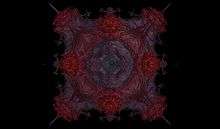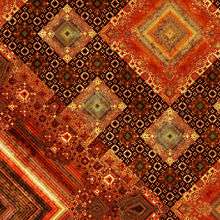Mandelbulb

The Mandelbulb is a three-dimensional fractal, constructed by Daniel White and Paul Nylander using spherical coordinates in 2009.[1]
A canonical 3-dimensional Mandelbrot set does not exist, since there is no 3-dimensional analogue of the 2-dimensional space of complex numbers. It is possible to construct Mandelbrot sets in 4 dimensions using quaternions. However, this set does not exhibit detail at all scales like the 2D Mandelbrot set does.
White and Nylander's formula for the "nth power" of the vector in ℝ3 is
where
,
, and
.
The Mandelbulb is then defined as the set of those in ℝ3 for which the orbit of under the iteration is bounded.[2] For n > 3, the result is a 3-dimensional bulb-like structure with fractal surface detail and a number of "lobes" depending on n. Many of their graphic renderings use n = 8. However, the equations can be simplified into rational polynomials when n is odd. For example, in the case n = 3, the third power can be simplified into the more elegant form:
- .
The Mandelbulb given by the formula above is actually one in a family of fractals given by parameters (p,q) given by:
Since p and q do not necessarily have to equal n for the identity |vn|=|v|n to hold. More general fractals can be found by setting
for functions f and g.
Quadratic formula
Other formulae come from identities which parametrise the sum of squares to give a power of the sum of squares such as:
which we can think of as a way to square a triplet of numbers so that the modulus is squared. So this gives, for example:
or various other permutations. This 'quadratic' formula can be applied several times to get many power-2 formulae.
Cubic formula

Other formulae come from identities which parametrise the sum of squares to give a power of the sum of squares such as:
which we can think of as a way to cube a triplet of numbers so that the modulus is cubed. So this gives:
or other permutations.
for example. This reduces to the complex fractal when z=0 and when y=0.
There are several ways to combine two such `cubic` transforms to get a power-9 transform which has slightly more structure.
Quintic formula


Another way to create Mandelbulbs with cubic symmetry is by taking the complex iteration formula for some integer m and adding terms to make it symmetrical in 3 dimensions but keeping the cross-sections to be the same 2 dimensional fractal. (The 4 comes from the fact that .) For example, take the case of . In two dimensions where this is:
This can be then extended to three dimensions to give:
for arbitrary constants A,B,C and D which give different Mandelbulbs (usually set to 0). The case gives a Mandelbulb most similar to the first example where n=9. A more pleasing result for the fifth power is got basing it on the formula: .

Power nine formula

This fractal has cross-sections of the power 9 Mandelbrot fractal. It has 32 small bulbs sprouting from the main sphere. It is defined by, for example:
These formula can be written in a shorter way:
and equivalently for the other coordinates.

Spherical formula
A perfect spherical formula can be defined as a formula:
where
where f,g and h are nth power rational trinomials and n is an integer. The cubic fractal above is an example.
In Popular Culture
- In the Disney movie Big Hero 6, the emotional climax takes place in the middle of a wormhole, which is represented by the stylized interior of a Mandelbulb.[3]
- The 2016 film Doctor Strange shows Mandelbulbs in some of the dimensions the Ancient One transports Strange to when displaying her power.
See also
References
- ↑ "Hypercomplex fractals".
- ↑ "Mandelbulb: The Unravelling of the Real 3D Mandelbrot Fractal". see "formula" section
- ↑ Desowitz, Bill (January 30, 2015). "Immersed in Movies: Going Into the 'Big Hero 6' Portal". Animation Scoop. Indiewire. Retrieved May 3, 2015.
External links
| Wikimedia Commons has media related to Mandelbulb. |
- Mandelbulb: The Unravelling of the Real 3D Mandelbrot Fractal, on Daniel White's website
- Several variants of the Mandelbulb, on Paul Nylander's website
- An opensource fractal renderer that can be used to create images of the Mandelbulb
- Formula for Mandelbulb/Juliabulb/Juliusbulb by Jules Ruis
- Mandelbulb/Juliabulb/Juliusbulb with examples of real 3D objects
- Video : View of the Mandelbulb
- The discussion thread in Fractalforums.com that lead to the Mandelbulb
- Video fly through of an animated Mandelbulb world
